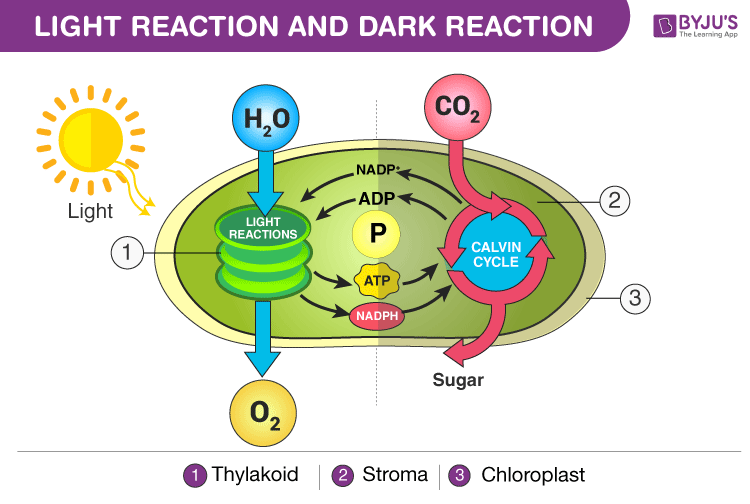Table of Contents
|
Overview |
| Light Reaction – Discover its definition and significance |
| Dark Reaction – Explore its meaning and implications |
| Difference between Light and Dark Reaction – Learn how these two processes vary from each other |
Photosynthesis is the process of conversion of light energy into chemical energy which can then be utilized by living organisms. It is a rather complex process which is carried out through various stages.
Photosynthesis comprises two phases:
- The first phase is the photochemical phase or light-dependent process. This phase is commonly known as the light reaction.
- The second phase is the biosynthetic phase of the dark reaction of photosynthesis. This phase is the light-independent process.
The whole process of photosynthesis takes place within the chloroplast.

Steps Carried out in Light Reaction and Dark Reaction
Light reaction And Dark reaction
As stated above, photosynthesis occurs in two phases – light reaction and dark reaction.
Light Reaction
The light reaction is a light-dependent process which includes a series of events such as light absorption, hydrolysis, the release of oxygen, formation of ATP and NADPH.
The light reaction of photosynthesis initiates only when it is supplied with light energy.
The photosystem is the arrangement of pigments, including chlorophyll within thylakoids.
There are two photosystems in plants:
- Photosystem I (PS-I)
- Photosystem II (PS-II)
Photosystem I absorbs light at a wavelength of 700 nm, whereas Photosystem II absorbs light at a wavelength of 680 nm.
The light reaction occurs in the thylakoids of the chloroplast. When the light hits, chlorophyll-a gets excited to a higher energy state followed by a series of reactions. This energy is converted into energy molecules ATP and NADPH by using PS I and PS II. Also, hydrolysis occurs and releases oxygen.
Also Read: Cyclic and non-cyclic photophosphorylation
Dark Reaction
Dark reaction is also called carbon-fixing reaction. It is a light-independent process in which sugar molecules are formed from the carbon dioxide and water molecules.
The dark reaction occurs in the stroma of the chloroplast, where they utilize the products of the light reaction.
Plants capture the carbon dioxide from the atmosphere through stomata and proceed to the Calvin cycle.
In the Calvin cycle, the ATP and NADPH formed during light reaction drives the reaction and convert six molecules of carbon dioxide into one sugar molecule, i.e. glucose.
Also Refer: Photosynthesis in Higher plants
Difference between Light and Dark Reaction
Following are the important differences between light and dark reaction:
|
Light Reaction |
Dark Reaction |
|
It takes place only in the presence of light. |
It can take place in the presence or absence of sunlight. |
|
It is a photochemical phase. |
It is a biochemical phase. |
|
It takes place in the grana of the chloroplast. |
It takes place in the stroma of the chloroplast. |
|
NADP utilizes H+ ions to form NADPH. |
The hydrogen of NADPH combines with CO2. |
|
The end products are ATP and NADPH. |
Glucose is the end product. ATP and NADPH help in the formation of glucose. |
|
The water molecules split into hydrogen and oxygen. |
Glucose is produced. Co2 is utilized in the dark reaction. |
|
Photolysis occurs in PS-II. |
Photolysis does not occur. |
Also Read: Difference between Cyclic and non-cyclic photophosphorylation
For more details on light reaction, dark reaction and the difference between light and dark reaction, keep visiting BYJU’S or download the BYJU’S app for further reference.
Frequently Asked Questions
What is a light reaction?
The light reaction takes place in the thylakoid membranes. In the light reaction, the light is absorbed and energy is used to drive electrons from water to generate NADPH and to drive protons across the membrane.
What is a dark reaction?
In the dark reaction, plants use carbon dioxide with ATP and NADPH from the light reactions to produce glucose. It takes place in the stroma of the chloroplast.
What are the end products of light reactions?
The end products of the light reaction are ATP and NADPH, also known as assimilatory powers.
What is the end product of the dark reaction?
Glucose is the end product of the dark reaction.
What is the difference between light and dark reaction?
The light reaction is the initial stage of photosynthesis which traps light energy to produce ATP and NADPH, whereas dark reaction is the second step of photosynthesis which utilizes the energy from ATP and NADPH to produce glucose.
Does the dark reaction occur at night?
No, the dark reaction does not occur at night. It occurs during the day, but the reaction does not use the light directly. Therefore, it is known as the dark reaction.
How does a plant make energy without light?
Plants make ATP from other sources such as metal ions and turn carbon dioxide into glucose. The anaerobic photosynthetic bacteria use light energy but do not have the light reactions as in plants and produce no oxygen.
How does light affect the growth of plants?
Light provides energy to plants through a process called photosynthesis. This energy helps the plant to grow. This is how plant growth is affected by light.
Also Read: Light-dependent reaction

nice chapter
Nice chapter
Very informative.
Best document
Can i get relation between light reaction and dark reaction with help of scymatic presentation
What is glycolisis?
A process in which glucose (sugar) is partially broken down by cells
Sir I AM so happy in by jis class